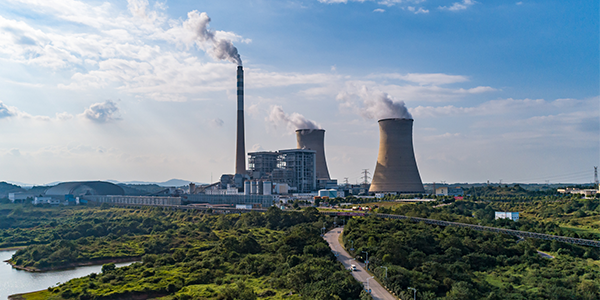
A New “Pink Tide” in Latin America?
Latin America tilted further left this week as Colombian voters elected to send Gustavo Petro to the country’s presidential palace. Come August, the former Bogotá mayor and member of the violent M-19 guerrilla organization will join the region’s growing list of leftist leaders in a political shift some are likening to the “pink tide” of the late 1990s and early 2000s.
Although voters in several Latin American countries managed to flip their countries back toward neoliberalism and free-market capitalism following the pink tide, it appears a new wave of populism has caused political appetites to shift yet again.
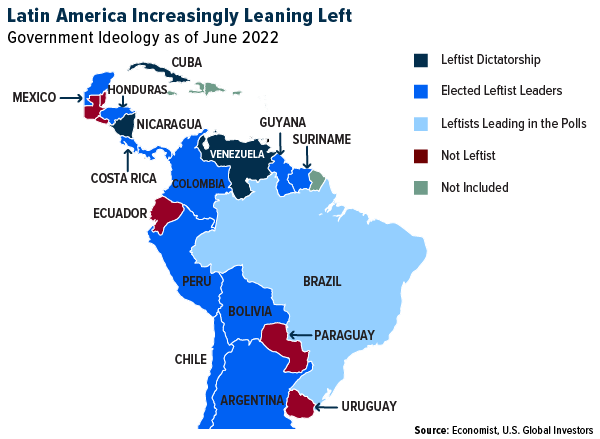
Besides Petro, we’ve seen the recent elections of leftists such as Mexico’s Andrés Manuel López Obrador (AMLO), Peru’s Pedro Castillo and Argentina’s Alberto Fernandez.
Meanwhile, in Brazil, former president Luiz Inácio Lula da Silva, who rode the earlier pink tide to power, is leading significantly in the polls against incumbent Jair Bolsonaro. The Trumpian Brazilian president, whose popularity has taken a hit from high inflation and soaring fuel prices, is reportedly considering raising monthly stipends to millions of poor families in an effort to improve his chances of reelection in October.
Some parts of Central and South America have yet to recover from the economic damage caused by the pink tide 20 to 25 years ago.
Nicaraguan president Daniel Ortega, who “won” a fourth term in November of last year after jailing his political opponents, has transformed the small Central American country into the region’s third full-blown dictatorship after Cuba and Venezuela. In March, Nicaragua’s own ambassador to the Organization of American States (OAS) bravely condemned the Ortega government for rolling back human rights and quashing free speech and political dissent.
I’ve written many times about Venezuela—once Latin America’s wealthiest country, now home to hyperinflation and near-universal poverty due to the failed socialist policies of Hugo Chávez and Nicolás Maduro.

Oil and Gas Companies May Find It Even Harder to Operate in Colombia
That brings me to Colombia’s Petro, who will become the country’s first leftist president. However implausible, there’s a legitimate fear that he could Venezuel-ify Colombia, one of the United States’ closest allies in the Western Hemisphere. I say “implausible” because, as things stand now, the Colombian president serves only one four-year term. But as they’ve proved time and again, autocrats find a way to hang onto power, whatever the cost.
The writer Maya Angelou once said that when someone shows you who they are, believe them the first time. Petro, 62, has shown us he’s no friend to personal property and liberties. He’s repeatedly praised Hugo Chávez and says he plans to normalize relations with Venezuela.
Embarrassingly, the president-elect retweeted a March 2021 post by liberal economist Paul Krugman in which he tried to make the case that trillions in money-printing has not caused inflation in the U.S. A year and a half after that original tweet, prices are rising at their fastest pace in 40 years.
Despite the fact that crude is Colombia’s number one export, Petro vows to be hostile toward the oil and gas industry and has pledged to stop awarding new exploration contracts. He allegedly wants to turn Ecopetrol, the country’s primary petroleum producer and biggest company of any kind by revenue, into a wind and solar provider. As Bloomberg reports, the Colombian government owns 85% of Ecopetrol, so there’s little to stop Petro from accomplishing this.
Shares of Canadian oil producers that operate in Colombia tumbled on Monday, the day after the election. The largest among them, Parex Resources, fell more than 10% in intraday trading before closing down 5.6%.
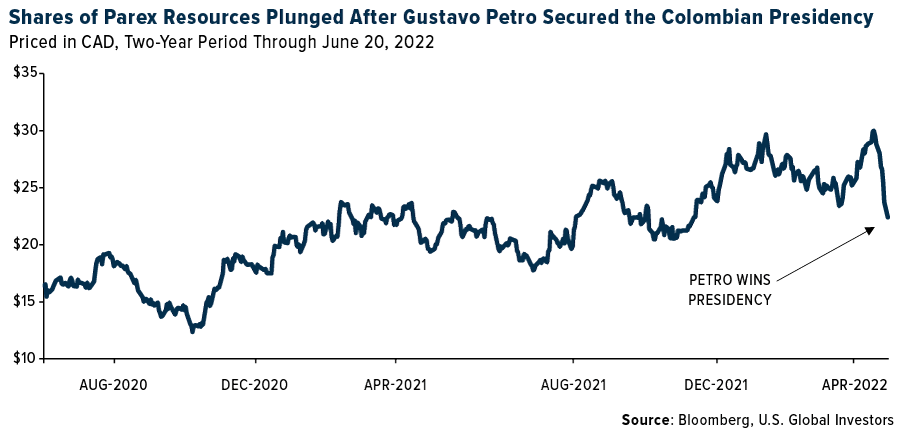
Latin Americans’ Growing Favorability of Cryptos
The only positive I can see from a Petro presidency derives from his surprising support of Bitcoin. As a decentralized asset, Bitcoin does not generally appeal to socialists like Petro, who seek to control all areas of the economy. However, he seems to like the cryptocurrency since it strips power from banks and eliminates the need to trust a third party.
To be fair, Petro’s favorable attitude toward Bitcoin is shared by a growing percentage of Latin Americans, many of whom have adopted crypto to get past currency controls and send money across borders, not to mention save their money for perhaps the first time in their lives. In a just-released report by Mastercard, an incredible 51% of Latin Americans have made a transaction using digital assets, including Bitcoin. I expect this figure to grow substantially over the next several years.
Climate Policies Have Driven Much of the Inflation We’re Seeing Now
Petro’s anti-fossil fuel ambitions face challenges from not just the constraints of a single four-year term but also a potentially uncooperative congress.
But for the sake of argument, let’s say he succeeds in halting all exploration and production in the country.
Such a move would surely add to the fuel price inflation we’re already experiencing across the globe. According to the International Energy Agency (IEA), world demand for oil is set to reach pre-pandemic levels next year as more people get back to traveling for leisure and business. At the same time, global investment in oil and gas projects has not fully recovered, nor is it expected to do so for the remainder of the year.
Take a look at the chart below. It shows you the 2016-2021 investment increase in research, development and demonstration (RD&D) budgets for select areas of the total global energy sector.
Fossil fuels trailed all other areas, receiving less new financing than energy efficiency, nuclear, hydrogen and fuel cells, renewables and even “cross-cutting,” which includes “women’s participation in clean energy,” “clean energy education and empowerment” and other activities.
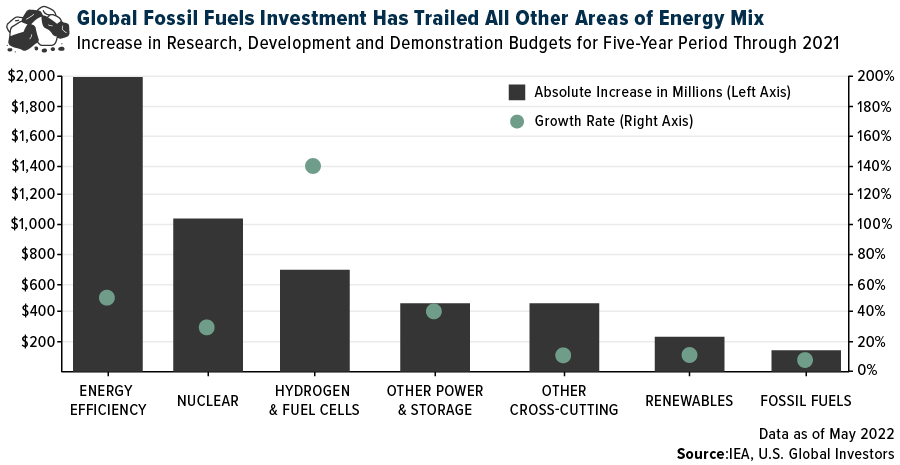
Again, this is all incredibly inflationary. Without adequate investment in traditional energy sources, we’ll continue to see sky-high fuel prices.
Oil Falls Below Key 50-Day Moving Average on Recession Fears
That said, oil traded down this week on fears that a recession could crimp demand. The price of Brent crude, the international benchmark, broke below its 50-day moving average, a possibly bearish signal.
Brent still appears to have strong support, as you can see from the 200-day moving average, so this could be a head fake.
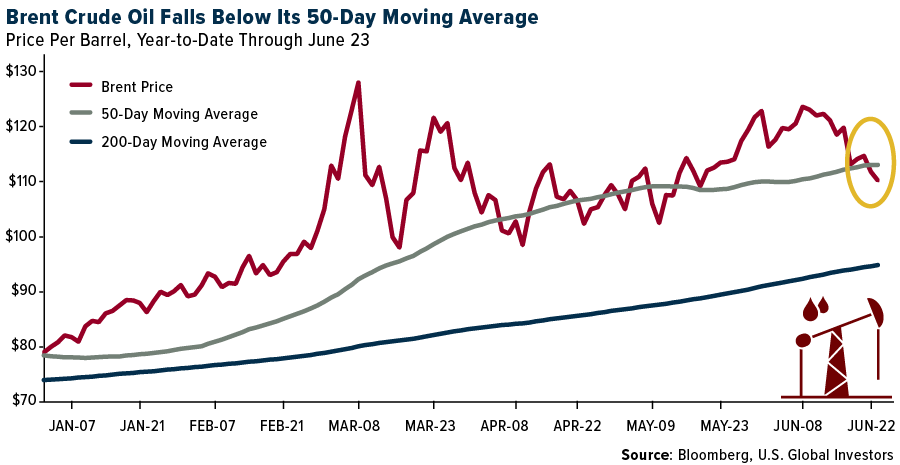
A meaningful drop in fuel costs would be welcome news for everyone, not least of all transportation-intensive companies from trucking to airlines to container shipping. Airlines have had to raise fares recently to offset surging fuel prices, while shipping rates are starting to tick back up after declining from their September 2021 peak.
1970s inflation is here. Find out what investors can do about it by clicking here!
Index Summary
- The major market indices finished up this week. The Dow Jones Industrial Average gained 5.39%. The S&P 500 Stock Index rose 6.46%, while the Nasdaq Composite climbed 7.49%. The Russell 2000 small capitalization index gained 6.00% this week.
- The Hang Seng Composite gained 3.33% this week; while Taiwan was down 16.00% and the KOSPI fell 20.52%.
- The 10-year Treasury bond yield fell 9 basis points to 3.134%.
Airline Sector
Strengths
- The best performing airline stock for the week was Cargojet Inc., up 19.6%. According to ISI, U.S. airline industry web traffic was 44% higher year-over-year a 41% increase last week. Among Latin American carriers tracked by ISI, web traffic is up 31% year-over-year. Volaris (Mexico) web traffic is up 69% versus 2019 and Copa (Panama) web traffic is higher by 78% versus 2019. European carrier web traffic is up 96% year-over-year.
- According to Volaris management, demand remains strong both on the domestic and international segments as seen per forward bookings. Going forward, the company believes it should be able to continue growing at high-single/low-double digits for the next couple of years. Regarding demand mix, management highlights that visiting friends and relatives (VFR) tends to be the most resilient segment, which should help Volaris even under more challenging macroeconomic environments.
- According to Morgan Stanley, travel managers expect their budgets to be down 25% versus 2019 in the first half of the year, a significant improvement from their previous survey when they expected the second half of 2021 to be down 39% versus 2019. By 2023, the average from respondents is for budgets to be back to 94% of 2019 levels. In another positive shift, the proportion that expect budgets to increase in 2022 has also risen, from 15% to 26%.
Weaknesses
- The worst performing airline stock for the week was Bombardier, down 14.2%. Allegiant provided a second quarter 2022 update with its May traffic release. Despite demand continuing to outpace supply, driving strong (87-90%) load factors, revenue is expected to come in at the low end of the prior guide due to cancellations.
- The NYSE Arca Airline Index is down 33% this quarter, underperforming every other index. In the last year, the stocks are down almost 50%, back to levels last seen in March of 2020. Investors are concerned about demand destruction in a recession if airlines are unable to recover the high cost of current jet fuel prices. Jet fuel is averaging $4.25 per gallon, putting pressure on margins. In addition to high jet fuel prices, the crack spreads are back to $1.50 per gallon, so airlines continue to try and keep fares at levels that enable them to recover costs.

- As flagged in easyJet’s latest update, higher disruption costs will mean lower results for the company in fiscal year 2022, driving its PBT down from GBP50 million to a GBP128 million loss. The airline also models higher costs for fiscal years 2023-2024 (reflecting oil and airport fees).
Opportunities
- JetBlue Airways announced Monday that it has sweetened its takeover offer for Spirit Airlines, reports Reuters, to $33.50 per share. The bid comes in hopes that the ultra-low-cost carrier will accept the offer over rival Frontier Airlines’ proposal. JetBlue’s latest bid represents a 68% premium to Frontier’s cash and stock offer. The takeover (by Frontier or JetBlue) would create the fifth-largest U.S. airline, the article continues.
- The 37th UBS Evidence Lab European Airline Fare Tracker is based on high frequency price observations within the booking window to capture fare pricing trends across different airlines. Recent observations suggest second quarter 2022 economy fares are up 37% (previously 30%) and premium fares are up 23% (previously 20%). Early indications for third quarter 2022 economy fares are 33% while premium fares are 23%.
- The International Air Transport Association (IATA) released an upgrade to its industry outlook, highlighting losses are expected to narrow to -$9.7 billion (a 16% improvement from -$11.6 billion in October). Overall, the IATA expects aggregate revenues to increase 55% and costs by 44% over 2021, with profitability dependent on cost controls. Profitability is expected industry wide in 2023, led by North American carriers, which are likely to be profitable this year due to strong domestic travel and international Atlantic travel.
Threats
- Raymond James’ initial reaction to American Airlines’ new pilot agreements with its regional subsidiaries is that it is mostly a short-sighted solution that could have a long-term negative impact on the regional airline industry. In turn, it could also have a long-term impact on the mainline airlines (as well as the communities) that rely on regional feed.
- Intra-Europe net sales declined by four points this week to -4% versus 2019, with a 1% week-on-week decline. International net sales increased by one point to -7% versus 2019 but were down by two points this week. This led to a one-point decline in system-wide net sales to -6% versus 2019, with a 2% decline this week.
- According to ISI, based on current scheduling data, third quarter 2022 planned growth for U.S. carriers is 100 basis points lower, down 6% versus 2019 compared with down 9% versus 2019 in the second quarter of 2022.
Emerging Markets
Strengths
- The best performing country in emerging Europe for the week was Romania, gaining 2.4%. The best performing country in Asia for the week was Hong Kong, gaining 3.5%.
- The Russian ruble was the best performing currency in emerging Europe this week, gaining 5.9%. The Pakistani rupee was the best performing currency in Asia this week, gaining 0.70%.
- Asian technology stocks outperformed this week. The Hang Seng Technology Index gained 4.12%. Chinese electric car maker, Xpeng, was the best performing equity, gaining 25.56% over the past five days.
Weaknesses
- The worst performing country in emerging Europe for the week was the Czech Republic, losing 0.40%. The worst performing country in Asia this week was the Philippines, losing 4.0%.
- The Turkish lira was the worst performing currency in emerging Europe this week, losing 0.22%. The Philippine peso, was the worst performing currency in Asia this week, losing 2.1%.
- Preliminary PMI data in the Eurozone dropped lower this week. Nevertheless, the numbers remain in expansionary territory above the 50 level that separates growth from contraction. Preliminary Eurozone Manufacturing PMI for June was reported at 52.0, down from 54.6 in May. Service PMI declined to 52.8, down from 56.1 in May.
Opportunities
- The White House is reviewing the removal of some Chinese tariffs as part of its battle against inflation. United States Treasury Secretary Yellen commented that several tariffs on Chinese products inherited from former President Donald Trump served “no strategic purpose.”
- Chinese equites remain in oversold territory, presenting potential buying opportunities for those who believe that the Asian nation’s Covid situation is improving, and further economic reopening will follow. Year-to-date, the Shanghai Stock Exchange is down 9%, but is already off its lowest April level. The price of the iShares China Large Cap ETF crossed above its 50-day moving average on May 31, suggesting more upside to follow.
- Eurozone leaders have drafted a joint statement stating that the European Union is granting candidacy status to Ukraine and Moldova. The countries will be expected to meet a set of conditions related to the rule of law, justice, and anti-corruption. EU leaders will also propose to Georgia that it can achieve the same status after meeting certain conditions.
Threats
- The world’s largest hedge fund firm, Bridgewater Associates, managed by Ray Dalio, has almost doubled its short position in Europe, increasing the amount from $5.7 billion last week to $10.5 billion this week. Now the hedge fund is holding 28 short positions against European companies, up from bets against 18 companies last week.
- A recent survey shows that nearly one-quarter of European companies in China are reviewing their investments and “considering shifting” current or planned investments outside of China’s borders in response to President Xi Jinping’s stringent Zero-Covid policy. The survey also highlights rising fears over worsening geopolitical tensions stemming from Russia’s invasion of Ukraine, with 7% of European companies operating in China saying they were reviewing investments directly because of the war in Ukraine, according to FactSet.
- Gazprom PJSC’s shipments through Nord Stream pipeline, the biggest pipeline to the European Union supplying energy from Russia, remain at about 40% of capacity. European gas inventories are about 55% full, with storage sites being refilled as normal. However, the supply disruption means achieving the target of 80% by November 1 will be difficult, ING Group NV said in a note. Energy costs could continue to rise in Europe on supply concerns from Russia.

Energy & Natural Resources
Strengths
- The best performing commodity for the week was uranium, up 3.96%, as proxied by the Sprott Physical Uranium Trust. Uranium is facing a fairly tight supply future with Russian supplies facing a potential import ban. Elevated copper prices in 2020-2022 have been driven by supportive S&D fundamentals including: 1) strong recovery in underlying demand post-Covid, 2) Buying/restocking, 3) mine and refined supply disruptions, and 4) low inventories. The physical market remains tight; visible inventories are very low, and supply is still struggling.
- Project spending by the 10 largest mining companies, including Rio Tinto PLC, BHP Group Ltd., and Glencore PLC, is expected to stay at roughly $40 billion this year and next year, according to figures compiled by Bank of America. That would put capital expenditures well below a 2012 peak, close to $80 billion, the bank’s figures show. Much like the oil industry, mining companies are responding to pressure from investors to give priority to dividends and share buybacks, rather than heavy spending. A recent push to limit the sector’s environmental damage also pinched spending.
- Bloomberg reported on the “marker margin” spread that BP Plc and TotalEnergies SE, which have oil refining and distribution operations across Europe, earn on processing a barrel of oil. Currently, the so-called marker margin is at $38 per barrel, which is five times higher than the same period last year. Sadly, good things don’t last forever.
Weaknesses
- The worst performing commodity for the week was cotton, down 17.11%, as worries that consumers will slash spending on clothes as inflation soars, ripped through the market. Cotton futures have fallen 36% from their decade high reached last month. Texas is on edge as fears of cotton losses mount with the worst drought in decades suppressing crop yields. The U.S. is the biggest exporter of cotton. Grains and industrial metals were also hit hard by recession fears.
- European natural gas prices are headed for the biggest weekly gain since Russia began its war on Ukraine as Moscow’s deep supply cuts reverberate across the region. Benchmark futures rose as much as 8.4%, taking this week’s gain to about 60%. Italian oil and gas company Eni S.p.A will receive just half of what it requested from Gazprom PJSC on Friday, compared with about two-thirds the previous day. The cuts have hit some of the biggest consumers in a blow to the region that’s already struggling with surging inflation and meager growth.
- Iron ore’s rout has extended to a seventh day, with the plunge taking prices back to levels last seen in January, as China’s Zero-Covid policy triggered concerns that disruptions to the industry will last for months to come. The steel-making ingredient has fallen about 12% so far this week, its heaviest weekly decline in more than seven months.

- It seems reasonable to conclude that the Federal Reserve will keep raising rates until oil and gas prices move sufficiently lower to curb inflationary pressures. Indeed, this process is already underway. WTI was down 11% over the last week and natural gas was 22% lower. The problem with this dynamic is that while lower petroleum prices may play a role in reducing inflationary pressures, it doesn’t encourage increased capital spending or production growth, which is what the price signals through 2022 have been screaming for.
Opportunities
- Zinc, like other base metals, has taken a hit from rising interest rates and now fears of an upcoming recession are packing a second punch. Jake Lloyd-Smith writes for Bloomberg that the current cash three-month spread on the LME for zinc has widened out to $160 per ton, high by historic standards, which speaks to healthy demand for the near-term supply. Against this backdrop, stockpiles on the LME have collapsed by more than 40% this quarter. Plus, on-warrant holdings, stockpiles already tagged for removal, have never been lower. Supplies are tight and if demand holds up, zinc could shine.
- JPMorgan global equity strategists expect mining to rebound and outperform in the second half of 2022, as new policy support and easing of Covid lockdowns drive a rebound in China’s activity. The bank cites a low barrier for earnings upgrades as the 2023 consensus already forecasts a 30% EPS decline for European mining. Miners have minimal debt and 10-30% FCF yields, which should support 10% capital returns in 2022 and estimated 2023, through dividends and share buybacks.
- JPMorgan has also commented that aluminum is likely insulated on the downside from elevated cost support levels. Regardless, Chinese supply growth continues to rebound significantly, and looser fundamentals will likely cap upside even as Chinese demand firms. Aluminum prices may average $2,750/mt in the third quarter of the year before European smelter closure risk likely boils up once again later in the year, pushing prices to average $2,850/mt in the fourth quarter.
Threats
- Energy has underperformed the broader market (S&P 500 down 5.8% versus the S&P 500 Energy Index down 17.2%). While some of the movement can be attributed to fears of recession, there are concerns that the proposals being floated by the White House to lower prices of gasoline and diesel are too punitive for the energy sector as a whole. These include stopping refined product exports / putting a cap on refined product exports, using the Defense Production Act to boost refining capacity, re-instating the crude export ban, a windfall profit tax on oil and gas companies, and a federal gas tax holiday.
- Cobalt prices are crashing back to earth, reports Bloomberg, as sellers offer increasingly steep concessions to Chinese buyers who have turned cold on the battery metal as demand slumps in electric vehicles and smartphones. The benchmark price for cobalt in Europe has slid more than 13% since a peak in May, and an even sharper decline in Chinese prices signals the sell-off could have further to run, the article continues.
- Ozone levels in the Permian Basin of West Texas have surpassed federal standards for several years, according to Jeremy Nickols, climate and energy program director for WildEarth Guardians which formally petitioned the EPA to act. Texas does not have any ozone monitoring stations in the Permian Basis but in neighboring New Mexico counties, readings are showing elevated ozone levels. The EPA is now weighing labeling parts of the Permian Basin as violating federal air quality standards for ozone. Such designation would force state regulators to develop plans to curb the emission which could spur new permitting requirements and scrutiny of drilling operations.
Luxury Goods
Strengths
- Swiss-watch exports strengthened year-over-year in the month of May, led by those priced above 3,000 francs, indicating solid demand for luxury goods and crafted timepieces. Products in the top range rose 20%, following a 12% gain in April. Units climbed almost 10%, highlighting the ability of premium luxury companies to pass higher costs on to buyers without losing volume.
- Bernstein’s analysts have recommended LVMH as a top luxury stock at a time of macroeconomic and geopolitical uncertainties, thanks in part to the French giant’s Dior mega-brand. Brand Finance determines the relative strength of brands through a balanced scorecard of metrics. Dior was named the strongest apparel brand in the ranking, with a AAA brand rating and a corresponding Brand Strength Index score of 88.4 out of 100.
- The RealReal Inc., an online retailer for luxury goods, was the best performing S&P Global Luxury stock for the week, gaining 38.8%. The stock reached a record low last Friday, losing 80% of its market share since the beginning of the year, but rebounded this week. Bank of America expects internet/e-commerce stocks to perform better in the second half of the year.
Weaknesses
- Morgan Stanley forecasts flat retail sales for Burberry year-over-year for the April-June quarter. Among the geographies, China (1/3 of sales) is clearly set to be the main drag, with revenues down 40% in the quarter. Sales in Europe remain very strong, thanks in part to the return of tourism across the region.
- The preliminary U.S. Manufacturing PMI reading declined to 52.4 in June, down from 57.0 in May, and below the expected reading of 56.0. The Service PMI dropped to 51.6 in June from 53.4 in May, also falling short of its expected reading of 53.3.
- Paradise Corporation, a gaming company that operates casino facilities in South Korea and Kenya, was the worst performing S&P Global Luxury stock for the week, losing 12.09%. Shares dropped more than 12% on Thursday, although no major news was reported on Bloomberg.
Opportunities
- A recent study by Bain & Company consultancy indicates that the global luxury market remains set for growth. The personal luxury goods market could see growth between EUR360-380 billion globally by 2025, supported by strong consumer appetite in China. According to this optimistic scenario, the market could reach a range of EUR320-330 billion by the end of 2022, up as much as 15% versus 2021. In a slower-pace scenario, the luxury goods market could reach EUR305-320 billion by year-end, up as much as 10% versus 2021.
- During last week’s Ferrari Capital Day, the firm outlined several upcoming initiatives including, 1) developing electric cars, 2) looking into hydrogen fuel, 3) reaching carbon neutrality by 2030 and 4) building a luxury lifestyle brand – all of which were addressed by chairman John Elkann and Ferrari’s CEO Benedetto Vigna. Ferrari’s revenues are projected to grow to 6.7 billion euros by 2026, from the expected 4.8 billion euros in 2022, with earnings before interest, taxes, depreciation, and amortization reaching between 2.5 billion and 2.7 billion euros, and a margin of between 38-40%.
- Technical analysis shows that luxury goods are currently in oversold territory, suggesting a bounce could potentially follow. The 60-day oscillator for the S&P Global Luxury Index, seen below, is oversold, down 2.05 sigma. Per historical observations, a rebound is likely to follow, which could present a good buying opportunity.

Threats
- As reported by the Korea Times, many wealthy consumers are starting to find it burdensome to purchase luxury goods these days. A recent survey by Deloitte shows that 74% of wealthy respondents say they are worried about current living costs that continue to increase. In addition, 54% of wealthy people predicted their financial status would not improve over the next three years, the article continues, which could negatively impact this sector of the market. “Rich people are often more sensitive about losing money,” a local fashion firm official said. “They only spend money when they have excess cash.”
- Luxury brands have cut their forecasts for growth in China from 18% to just 3%, as Covid lockdowns continue to shatter consumer confidence. Management consultants Oliver Wyman published its findings based on interviews with clients representing more than $50 billion in retail sales of premium consumer and luxury goods in the country. There is a huge doubt about whether the consumer confidence can recover quickly, as in 2020 and 2021.
- Barclays published a report analyzing the results of a survey conducted of over 2,000 U.K. consumers. The survey attempts to shine light on the cost-of-living crisis and the potential implications this has on spending. According to the survey, around 50% of consumers are expected to cut back on discretionary spending over the next 12 months, with the most significant cutbacks on luxury spending, gambling, memberships, big-ticket purchases, and food on the go.
Blockchain and Digital Currencies
Strengths
- Of the cryptocurrencies tracked by CoinMarketCap, the best performer for the week was Metaxa, rising 1,270.08%.
- One of the biggest crypto lenders, BlockFi Inc., said digital-asset trading powerhouse FTX agreed to provide a $250 million revolving credit facility as concern increases across the sector about liquidity in the wake of the recent collapse in token prices, reports Bloomberg. Billionaire co-founder and CEO of FTX Sam Bankman-Fried said in a tweet that the exchange provided the support to help BlockFi “navigate the market from a position of strength,” the article continues.
- FalconX, a digital asset trading platform and brokerage for institutional investors, has doubled its valuation to $8 billion, despite a major market downturn for cryptocurrency. FalconX’s new funding round shows that there is still some investor appetite for crypto. The company’s valuation puts it on par with some of the biggest names in the crypto space, according to Bloomberg.
Weaknesses
- Of the cryptocurrencies tracked by CoinMarketCap, the worst performing for the week was Chicken KFC, down 100%.
- Recent market turmoil and the collapsing value of major stablecoins serve as reminders that “crypto is not sound money,” says the Bank for International Settlements. While the industry has exposed certain technological possibilities, cryptocurrencies do not meet other needs of usable digital money such as safety, accountability, efficiency, inclusion and openness, the institution commented in a report published this week and reported by Bloomberg.
- Cryptocurrency mining company Bitfarms has made an about-face on its holding strategy, selling 3,000 Bitcoin for $62 million over the past week, reports Bloomberg, to boost its liquidity amid the record-breaking bear market. Bitfarms is one of the first self-proclaimed Bitcoin hoarding miners to turn away from accumulating mined coins. The Toronto-based company is the latest of the public mining companies that have had to sell its crypto assets in order to stay afloat, the article continues.
Opportunities
- Bitcoin may extend its rebound above $20,000, according to technical analysis. This could suggest a broader recovery across other cryptocurrencies which have also weakened significantly. Bitcoin soared 16% on Sunday ending an unprecedented 12-day drop which sent it below $18,000 for the first time since 2020, Bloomberg reports.
- Binance.US, the American affiliate of the largest global crypto exchange, is starting to offer zero-fee trading for Bitcoin, with plans to eliminate the charges for more tokens in the future. Users can see a live order book on the platform for matching trades and over time Binance.US expects to add more tokens to its free trading category, according to Bloomberg.
- The company suing the U.S. Labor Department over threats to investigate cryptocurrency-friendly retirement plans is set to launch the nation’s first crypto-accessible workplace 401(k) this summer, company officials told Bloomberg Law. The rollout will likely transform what has, until now, been a theoretical showdown between fintech firms and federal regulators over the role of digital assets in employer-sponsored retirement plans, writes Bloomberg.
Threats
- South Korea has banned current and former employees of Terraform Labs from leaving the country, suggesting prosecutors are stepping up their investigation into the TerraUSD stablecoin collapse. Around $40 billion in market value was erased for holders of UST and its sister coin Luna when the stablecoin plunged far below its $1 peg, Bloomberg explains.
- Voyager Digital faces steep losses if the crypto broker is unable to recoup a loan it made to troubled digital asset hedge fund Three Arrow Capital, Bloomberg reports. Voyager said it may issue a notice of default to Three Arrows for failure to repay the loan. The broker’s exposure to Three Arrows included 15,250 Bitcoin and $350 million of stablecoin USDC, worth about $660 million based on Bitcoin’s price Wednesday morning in New York.
- Bitcoin resumed a fall mid-week, moving in tandem with weakening stocks amid mounting concerns about a global recession. Cryptocurrencies have been moving for months in the same direction as stocks, and Wednesday’s moves were no exception as investor appetite for risk assets ebbed on growing fears about an economic downturn, according to Bloomberg.

Gold Market
This week gold futures closed at $1,827.60, down $13.00 per ounce, or 0.71%. Gold stocks, as measured by the NYSE Arca Gold Miners Index, ended the week lower by 2.71%. The S&P/TSX Venture Index came in up 1.00%. The U.S. Trade-Weighted Dollar rose/fell 0.55%.
| Date | Event | Survey | Actual– | Prior |
|---|---|---|---|---|
| Jun-23 | Initial Jobless Claims | 226k | 229k | 231k |
| Jun-24 | New Home Sales | 590k | 696k | 629k |
| Jun-27 | Hong Kong Exports YoY | — | — | 1.1% |
| Jun-27 | Durable Goods Orders | 0.2% | — | 0.5% |
| Jun-28 | Conf. Board Consumer Confidence | 100.0 | — | 106.4 |
| Jun-29 | Germany CPI YoY | 7.9% | — | 7.9% |
| Jun-29 | GDP Annualized QoQ | -1.5% | — | 1.5% |
| Jun-30 | Initial Jobless Claims | 230k | — | 229k |
| Jun-30 | Caixin China PMI Mfg | 49.4 | — | 48.1 |
| Jul-01 | Eurozone CPI Core YoY | 3.9% | — | 3.8% |
| Jul-01 | ISM Manufacturing | 55.0 | — | 26.1 |
Strengths
- The best performing precious metal for the week was palladium, up 3.41%, perhaps on news that Sibanye says its Stillwater Mine could be idle for up to six weeks after the Yellowstone flooding. Gold has largely held firm this week as the dollar and bond yields sank on growing concerns about an economic downturn, reports Bloomberg. This comes after Federal Reserve Chair Jerome Powell vowed to curb inflation and said that a recession could be a possibility. With markets still focusing on central bank tightening to contain price pressure and the impact of those actions on global growth, the yellow metal has been holding in a narrow range this week, the article continues.

- Exchange-traded funds (ETFs) added 334,758 troy ounces of gold to their holdings in the last trading session, bringing this year’s net purchases to 7.27 million ounces, according to data compiled by Bloomberg. This was the biggest one-day increase since April 13. The purchases were equivalent to $615.8 million at the previous spot price. Total gold held by ETFs has risen 7.4% this year to 105.1 million ounces.
- RBC sees the proposed Kumtor agreement as removing a significant overhang for Centerra Gold shares and increasing management’s near-term flexibility in terms of funding growth post-2024 and potential additional cash return. The terms of the agreement are materially unchanged, with the Kyrgyz government transferring the 77.4 million shares it controls for cancellation, in exchange for Kumtor. Centerra Gold will also make cash payments totaling $87 million for withholding taxes and to settle inter-company claims.
Weaknesses
- The worst performing precious metal for the week was platinum, down 2.85% on little news. Gold miner Dacian Gold has spent years trying to engineer a turnaround story after it struggled in the early days at its $200 million Mt Morgans gold mine, reports Stockhead.com. Unfortunately, high inflation has forced the company to scale back. “In light of the current high inflationary environment, the board has taken the decision to reset the company strategy by discontinuing the current open pit mining operations at Mt Morgans,” Dacian chair Mick Wilkes said.
- Russia’s government and parliament are seeking to change rules on the sales and management of the country’s precious metals and gem stockpiles amid the war with Ukraine. The Finance Ministry proposed this week to put a portion of the country’s precious metals and gems into a special reserve that can be accessed in times of war, according to the government documents website. If the proposal passes, the president will have more rights to decide what to do with those reserves.
- Switzerland has imported gold from Russia for the first time since the invasion of Ukraine, showing that the industry’s stance toward the nation’s precious metals may be softening. More than three tons of gold was shipped to Switzerland from Russia in May, according to data from the Swiss Federal Customs Administration. That is the first shipment between the countries since February. The shipments represent about 2% of gold imports into the key refining hub last month.
Opportunities
- Yamana Gold’s executive chairman Peter Marrone expects shareholders of Gold Fields to come around to the deal’s benefits. “It will become very obvious that this is two pieces of a puzzle that fit nicely together.” Mr. Marrone went on to say, “The more I learn of what their shareholders are asking in terms of information — and the little bits of what they do reveal in terms of where they’re leaning — it certainly suggests to me that they see it just as compelling for them as it is for the shareholders of Yamana.” Shareholder votes are expected in the third quarter of 2022. Gold Fields is required to secure 75% of shareholder support for deal approval whereas Yamana requires about 67%.
- With an elevated cost of capital for developers, royalty/streaming companies are a relevant alternative for project financing. While part of the developer strategy is typically to look at value crystallization through being acquired, the mismatch between junior equity valuations and the robust nature of the majors at current metal prices make this dynamic even more poignant.
- According to Stifel, miners are poised to deliver outsized capital returns to shareholders through dividends and share buybacks over the coming years. The phase of deleveraging following significant investment in growth over a decade ago is nearing completion. Investing in new growth has been a challenge and continues to face obstacles, further bolstering balance sheets. This leaves dividends and buybacks, and the next destination for excess cash, sitting idle on the balance sheet. While the larger miners in their analysis are already paying an attractive average dividend yield of 5%, they see room for higher returns (dividends and buybacks) in the coming years as buoyant commodity prices and a lack of sizable growth opportunities create an ideal scenario for heightened shareholder returns.
Threats
- Angola has seized a stake in the nation’s biggest diamond miner, reports the Financial Times, giving it majority control of one of the world’s largest gem firms in a move that marks the waning influence of Chinese investors in the southern African nation. Catoca owns the world’s fourth-largest diamond mine. Catoca’s owners include Russia’s Alrosa, the world’s biggest diamond miner and subject of U.S. sanctions, Angolan state diamond company Endiama and until recently, LLI International. With the takeover of the Catoca stake, “the government is trying to reassure investors that they are cleaning up the sector” and demonstrate its efforts to cut ties with China Sonangol, said Alex Vines, Africa program director at Chatham House and an Angola expert.
- Sibanye Stillwater says resumption of mining at Montana-based operations affected by flooding in the area could take up to four weeks, according to a company spokesman. It could take at least a month to repair access roads and bridges linking to Stillwater’s East and West operations, James Wellsted said. The East Boulder mine is operating normally; revised output guidance will be disclosed once repairs to damaged infrastructure are complete.
- According to Morgan Stanley, gold looks overvalued versus recent moves in real yields. However, some support is coming through from still strong inflation and rising risks of recession, and sentiment could turn if rate expectations start to reverse.
U.S. Global Investors, Inc. is an investment adviser registered with the Securities and Exchange Commission (“SEC”). This does not mean that we are sponsored, recommended, or approved by the SEC, or that our abilities or qualifications in any respect have been passed upon by the SEC or any officer of the SEC.
This commentary should not be considered a solicitation or offering of any investment product. Certain materials in this commentary may contain dated information. The information provided was current at the time of publication. Some links above may be directed to third-party websites. U.S. Global Investors does not endorse all information supplied by these websites and is not responsible for their content. All opinions expressed and data provided are subject to change without notice. Some of these opinions may not be appropriate to every investor.
Holdings may change daily. Holdings are reported as of the most recent quarter-end. The following securities mentioned in the article were held by one or more accounts managed by U.S. Global Investors as of (03/31/22):
Gazprom Neft PJSC
Centerra Gold
Yamana Gold Inc.
Gold Fields Ltd.
Sibanye Stillwater
Allegiant Travel Co.
easyJet PLC
JetBlue Airways Corp.
Spirit Airlines
American Airlines
Christian Dior SE
LVMH Moet Hennessy Louis Vuitton
TotalEnergies
*The above-mentioned indices are not total returns. These returns reflect simple appreciation only and do not reflect dividend reinvestment.
The Dow Jones Industrial Average is a price-weighted average of 30 blue chip stocks that are generally leaders in their industry. The S&P 500 Stock Index is a widely recognized capitalization-weighted index of 500 common stock prices in U.S. companies. The Nasdaq Composite Index is a capitalization-weighted index of all Nasdaq National Market and SmallCap stocks. The Russell 2000 Index® is a U.S. equity index measuring the performance of the 2,000 smallest companies in the Russell 3000®, a widely recognized small-cap index.
The Hang Seng Composite Index is a market capitalization-weighted index that comprises the top 200 companies listed on Stock Exchange of Hong Kong, based on average market cap for the 12 months. The Taiwan Stock Exchange Index is a capitalization-weighted index of all listed common shares traded on the Taiwan Stock Exchange. The Korea Stock Price Index is a capitalization-weighted index of all common shares and preferred shares on the Korean Stock Exchanges.
The Philadelphia Stock Exchange Gold and Silver Index (XAU) is a capitalization-weighted index that includes the leading companies involved in the mining of gold and silver. The U.S. Trade Weighted Dollar Index provides a general indication of the international value of the U.S. dollar. The S&P/TSX Canadian Gold Capped Sector Index is a modified capitalization-weighted index, whose equity weights are capped 25 percent and index constituents are derived from a subset stock pool of S&P/TSX Composite Index stocks. The NYSE Arca Gold Miners Index is a modified market capitalization weighted index comprised of publicly traded companies involved primarily in the mining for gold and silver. The S&P/TSX Venture Composite Index is a broad market indicator for the Canadian venture capital market. The index is market capitalization weighted and, at its inception, included 531 companies. A quarterly revision process is used to remove companies that comprise less than 0.05% of the weight of the index, and add companies whose weight, when included, will be greater than 0.05% of the index.
The S&P 500 Energy Index is a capitalization-weighted index that tracks the companies in the energy sector as a subset of the S&P 500. The S&P 500 Materials Index is a capitalization-weighted index that tracks the companies in the material sector as a subset of the S&P 500. The S&P 500 Financials Index is a capitalization-weighted index. The index was developed with a base level of 10 for the 1941-43 base period. The S&P 500 Industrials Index is a Materials Index is a capitalization-weighted index that tracks the companies in the industrial sector as a subset of the S&P 500. The S&P 500 Consumer Discretionary Index is a capitalization-weighted index that tracks the companies in the consumer discretionary sector as a subset of the S&P 500. The S&P 500 Information Technology Index is a capitalization-weighted index that tracks the companies in the information technology sector as a subset of the S&P 500. The S&P 500 Consumer Staples Index is a Materials Index is a capitalization-weighted index that tracks the companies in the consumer staples sector as a subset of the S&P 500. The S&P 500 Utilities Index is a capitalization-weighted index that tracks the companies in the utilities sector as a subset of the S&P 500. The S&P 500 Healthcare Index is a capitalization-weighted index that tracks the companies in the healthcare sector as a subset of the S&P 500. The S&P 500 Telecom Index is a Materials Index is a capitalization-weighted index that tracks the companies in the telecom sector as a subset of the S&P 500.
The Consumer Price Index (CPI) is one of the most widely recognized price measures for tracking the price of a market basket of goods and services purchased by individuals. The weights of components are based on consumer spending patterns. The Purchasing Manager’s Index is an indicator of the economic health of the manufacturing sector. The PMI index is based on five major indicators: new orders, inventory levels, production, supplier deliveries and the employment environment. Gross domestic product (GDP) is the monetary value of all the finished goods and services produced within a country’s borders in a specific time period, though GDP is usually calculated on an annual basis. It includes all private and public consumption, government outlays, investments and exports less imports that occur within a defined territory.
The S&P 500 Energy comprises those companies included in the S&P 500 that are classified as members of the GICS energy sector.
A dividend is a distribution of profits by a corporation to its shareholders. When a corporation earns a profit or surplus, it is able to pay a proportion of the profit as a dividend to shareholders.
Hang Seng TECH Index represents the 30 largest technology companies listed in Hong Kong that have high business exposure to technology themes and pass the index’s screening criteria.
The NYSE Arca Global Airline Index is a modified equal dollar weighted index designed to measure the performance of highly capitalized and liquid international airline companies.
The standard deviation is a statistic that measures the dispersion of a dataset relative to its mean and is calculated as the square root of the variance.
The S&P Global Luxury Index is comprised of 80 of the largest publicly-traded companies engaged in the production or distribution of luxury goods or the provision of luxury services that meet specific investibility requirements.















